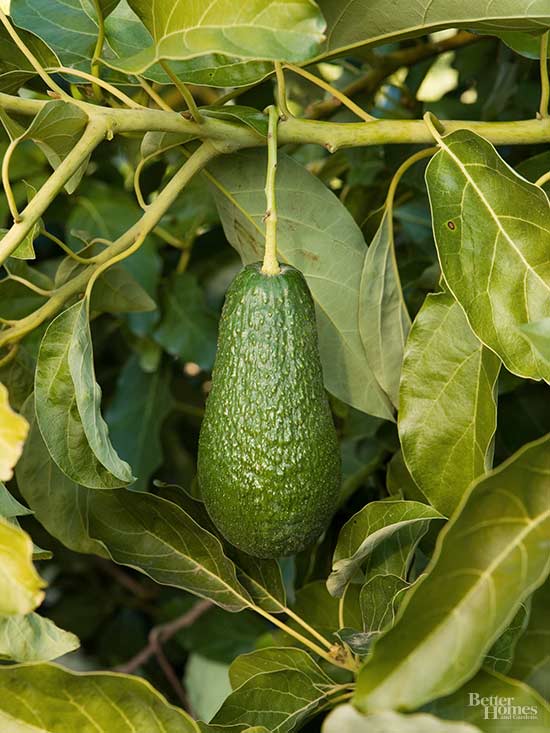






It's easy to sprout an avocado seed, as you may have learned in childhood. Buy an avocado, enjoy the luscious green flesh, then wash the seed. Remember which end of the seed was on top and which was the bottom.
1. Poke a toothpick in the center of the seed, about where the equator would be on a globe, tucking just about ¼ to ½ inch into the seed. Then poke two to three more toothpicks into the seed so the toothpicks are equally distributed.
2. Place the circle of toothpicks over a jar or glass filled with water, with the broad or flat (bottom) end of the avocado seed suspended in about 1 inch of water. Leave the top end open to the air. If the toothpicks wobble and don't hold the seed up, just stick them farther into the seed.
3. Place the glass somewhere warm but away from direct sunlight, adding water so there's always about 1 inch of water covering the bottom end of the seed. Every four or five days, completely change the water in the jar to eliminate bacteria that may be growing. Roots will grow from the bottom of the seed, and a slender seedling should emerge from the top in about eight weeks. If nothing happens after eight weeks, begin again with another seed. (Did you really put the right end into the water?)
4. When the seedling reaches 6 or 7 inches tall, cut the stem in half, or about 3 inches tall. This may seem cruel, but it allows the plant to begin putting its energies into new growth.
5. When the seedling has several leaves and thick roots, plant the seed in potting soil in a 10-inch-wide pot that has drainage holes. Do not add gravel, chunks of broken terra cotta, or other material to the bottom of the pot; they'll hold too much moisture. Leave the top half of the seed exposed above the soil line. Water the soil until water runs out of the bottom of the pot. Don't let the pot sit in a saucer of water; too much water can rot the roots and cause the leaves to turn yellow. Water deeply whenever the soil feels dry to the touch up to your first knuckle. If your plant has yellow leaves and wet soil, you are overwatering. Allow the soil to dry out between waterings.
6. Place the pot in a sunny window indoors, or move it outside any time when the temperature is 45 degrees F or warmer. Water more frequently when the plant is kept outside in warm, dry weather. Keep young potted avocado trees in partial shade; the leaves can sunburn if they get too much direct sun while they're still getting established.
7. Prune the tree regularly. Every time it grows another 6 inches tall, cut back the top two sets of leaves. When the plant reaches 12 inches, cut it back to 6 inches. When it reaches 18 inches, cut it back to 12 inches, and so forth. This encourages bushier growth. As the tree grows, gently remove it and place it in successively larger pots, going up in diameter two inches at a time.
8. In summer, fertilize weekly with a fertilizer with nitrogen, indicated by a higher first number, such as 7-4-2. Avocados also need a small amount of zinc so look for a fertilizer with that component. Avoid fertilizing during the winter when growth is minimal.
9. Avocados don't ripen on the tree. Pick them when they reach a normal size then wait for several days for the flesh to soften.
continue reading belowAvocado trees are subtropical plants native to southern Mexico. If you live in a region where winter temperatures regularly drop below freezing (in the United States, only the southernmost tips are suitable for outdoor avocado planting), plant the avocado tree in a container so you can move it indoors for winter. Indoor avocado trees should be grown in potting soil, not garden soil, to allow air and water to circulate freely.
If you live in a warm enough hardiness zone, you can plant outdoors. Avocados perform best in temperatures between 60 to 85 degrees F.
Place the plant in a spot where it gets at least 8 hours of sun per day. Dig a hole that is slightly wider than the current root ball but only as deep as the root ball. Planting too deeply or too far above ground level can cause problems.
Try not to disturb the root system during planting. Water the newly planted avocado tree every 5 to 10 days with several gallons of water. It's better to water deeply less often to force the roots to grow to reach water. Keeping about 6 inches away from the tree trunk, mulch with about 3 to 6 inches of coarse bark or cocoa bean hulls to retain moisture.
There are two reasons why you may never harvest an avocado.
First: You may lose patience. It can take five to 13 years or more for an avocado plant grown from seed to flower and set fruit. Seeing blossoms but not fruit? It's normal for an avocado tree to shed many flowers.
Second: Mature avocado trees reach 15 to 35 feet tall. You may decide it's too difficult to grow such a large tree indoors or move it inside and out, depending on the season.
Even if you don't ever have fruit, it's fun to watch an avocado tree grow. And you can always get avocados from a grocery store to enjoy guacamole and other recipes.

If you have avocado tree growing success, put those tasty avocados to work in these avocado recipes.
Our top avocado recipes
Avocado toast recipe ideas
Guacamole recipes
Copyright © www.100flowers.win Botanic Garden All Rights Reserved